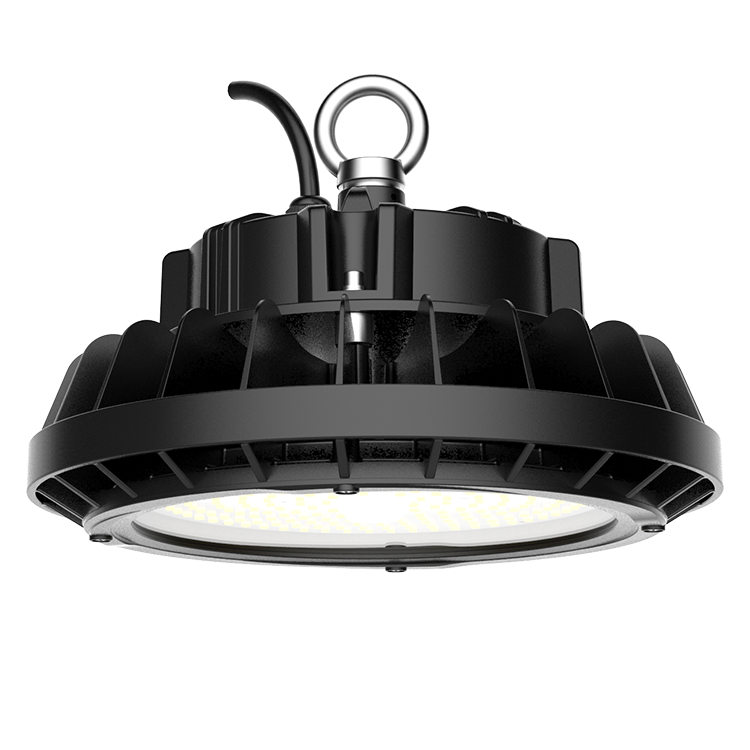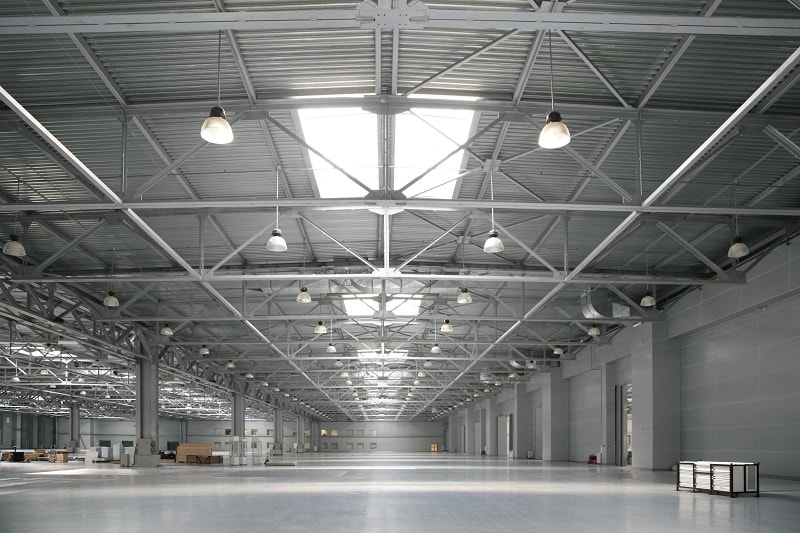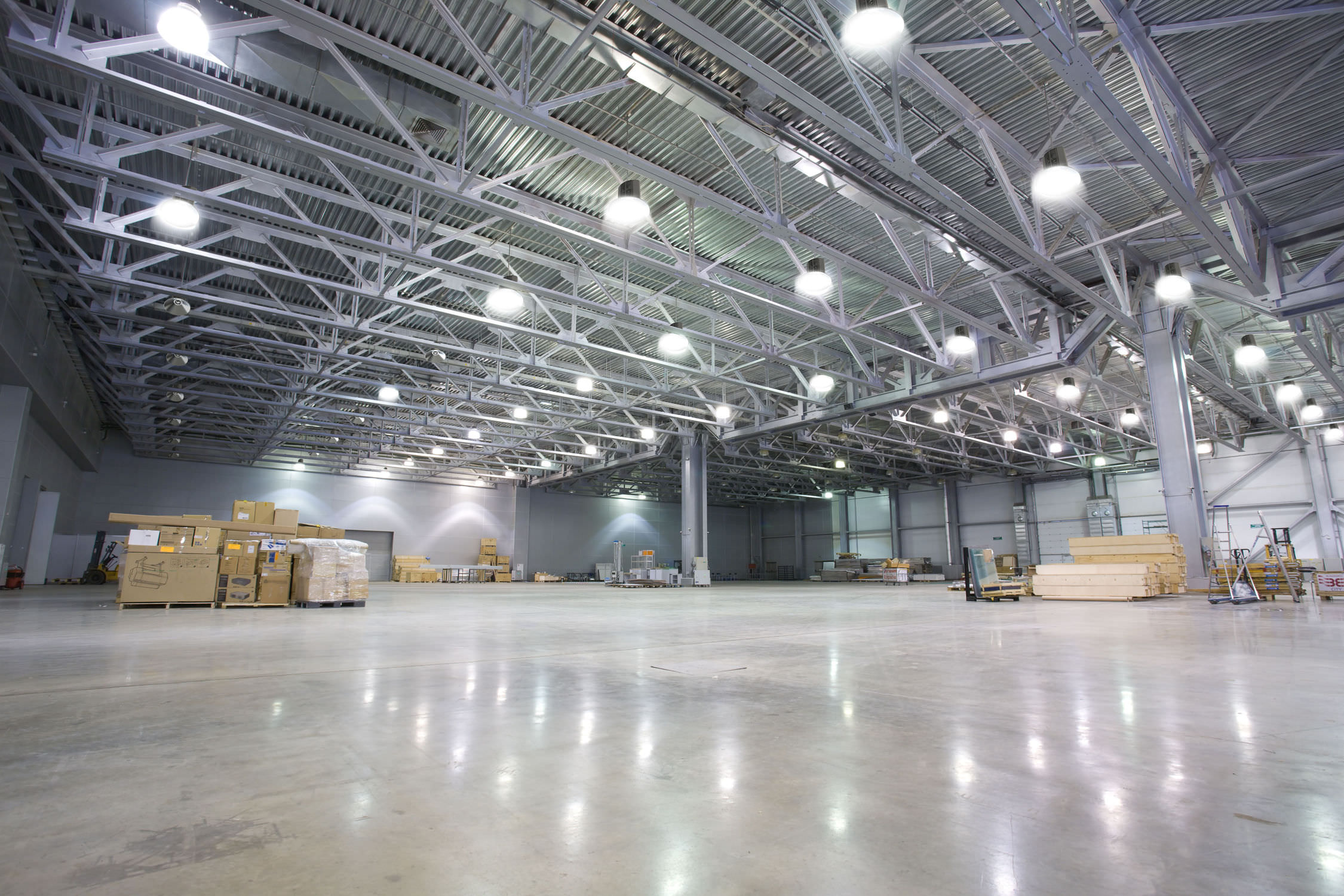What are High Bay Commercial LED Lights and how can they benefit your applications?
high-bay lighting is often used when large indoor spaces need to be lit. These spaces include warehouses, factories, large department stores, manufacturing plants, and other large spaces. For this reason, powerful lighting is required to illuminate the space at the right foot-candle levels. The high bay commercial LED lights & fixtures are typically suspended from the ceiling using hooks, chains or pendants. They can also be attached directly to the ceiling (similar to troffer light). This image shows high bay commercial LED lighting in action.
High bay commercial LED lighting is required by many industries and facilities. The most popular are:
• Warehouses
• Industrial Outdoor Lights (read more about Industrial LED Lighting ).
• Gymnasiums at schools and universities
• Municipal facilities such as community centers and recreation centers
• Commercial applications like department stores
Why choose LED High Bay Commercial Lighting Solutions over other Traditional High Bay Lights?
There were many industrial and commercial lighting solutions used in industrial and warehouse settings. Metal halide (MH), fluorescent, and high pressure sodium (HPS) are some of the most popular. Each of these bulbs has its merits but industrial LED lighting is superior to conventional ones in many ways. Let's look at the different considerations that should be taken into account when choosing a retrofit for your warehouse or industrial space.
Metal halide high-bay lights vs industrial LED lights:
You've probably seen metal halide lighting the field at a ballgame. MH lamps are used in industrial and sporting settings. The advantages of MH lamps include good color rendering, and relatively adequate foot-candle levels (as compared to other types). They take a while to warm up, sometimes taking between 15-30 minutes. They are also expensive to maintain and have a tendency to flicker. They also produce heat, so much of their energy is lost. Learn more about industrial led lights.
LED high-bay lighting vs. high pressure sodium (HPS), lights:
HPS lights are commonly used in warehouses, industrial, commercial, and other areas where high bay lighting is needed. They are inexpensive to sell, have high energy efficiency (low running costs), and last a long time. These advantages are retained by HPS lighting technology but LED high-bay lighting has a better track record. HPS bulbs have the worst color rendering and the longest warm-up period. Learn more about LED vs. Low Pressure Sodium Lights.
Commercial LED lighting vs. industrial LED lighting:
Although less common than Commercial LED lighting, Commercial lighting can be used in warehouses and other industrial settings (primarily T12, T8, and T5 lighting). Commercial lights offer a lower initial cost and a higher efficiency than conventional bulbs. There are downsides, such as the presence of toxic mercury that requires specific waste disposal procedures, decreased lifespan if the light is switched on and off, and the need for ballast to stabilize it. Learn more about commercial led lights versus industrial led lights.
What are the three main benefits of LED Lighting Planning in all applications, including high-bay?
It is no secret that LED Lighting Solutions is far more efficient than conventional lighting. These are just a few of the benefits that LED batten lights Australia wide offers. They also have three other general benefits that can be applied to all lighting applications.
Less maintenance required:
Street Lights last up to 40 years, which is more than most conventional bulbs. This allows for fewer replacements of bulbs that fail. The street lights Australia's Lighting Solutions produces light in a different way than traditional fuel or filament lighting. This is done by using a diode (learn a lot more in this). This means there are fewer moving parts to break and therefore, less repairs or replacements. Warehouse lighting and industrial lighting require special maintenance. High bay lighting planning is defined as having higher mounting heights. This means that it is more difficult to change a bulb without specialized equipment. Generally, bulbs can be swapped or replaced using scaffolding, hydraulic lifts, or catwalks. Each of these options can add to maintenance and equipment costs. The lifespan of commercial led lights is longer, so fixtures are less likely to need to be replaced. This can translate into savings for your bottom line.
Improved lighting quality:
Industrial LED lighting planning and batten lights Australia will typically score better in a head-to-head comparisons against most other bulbs when it comes to color rendering index (CRI), correlated color temperature (CCT), and foot candles. CRI is a measurement of a light’s ability to reveal the actual color of objects as compared to an ideal light source (natural light). In non-technical terms, CCT generally describes the “glow” given off by a bulb - is it warm (reddish), or cold (bluish white)? Foot candles compare the amount of light coming from a source and the amount of light hitting the desired surface; they’re basically a measure of efficiency. On all three fronts, LED lights perform very well. (Read more about blogs here.)
Increased Energy Efficiency of Industrial Outdoor Lights:
Not only do LED lights generate light differently, they also distribute light differently than conventional lighting solutions, which results in less energy required to provide the same output. How does that work? First, many conventional lights waste a lot of the energy they produce by emitting it as heat (this is especially the case with metal halide lighting). Second, most conventional lights are omnidirectional, which means that they output light in 360 degrees. So, a lot of light is wasted pointing at a ceiling, or being diluted because it has to be redirected through the use of fixtures. Outdoor led flood lights for applications that require industrial lighting solutions, these two problems of wasted energy (through heat loss and omnidirectional emission).
Do you have more questions about high bay lighting?
We’ve compiled a lot of resources to help facility managers and owners learn about LED lighting and how it can benefit particular applications. Visit our “LED Lights” page to learn about specific types of fixtures (such as high bay or other industrial LED lighting fixtures), or view case studies for similar organizations to see what the results were for their LED. As always, please feel free to reach out and ask us any questions directly - we would be honored to help you on your way to improved energy efficient lighting solutions.




























